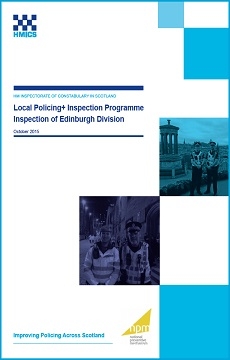This inspection, which forms part of our published scrutiny programme, is the third in our Local Policing+ inspection programme and aims to assess the state, effectiveness and efficiency of local policing in Edinburgh Division.
Effective local policing is fundamental to the success of Scottish policing. It is the part of policing that interacts with the public on a daily basis and is essential in building good relations with persons, localities and communities in Scotland. Strong local relationships strengthen the legitimacy of Police Scotland to carry out its function and support communities to improve their safety and well-being. Effective local scrutiny and engagement are also essential to the success of policing, through the identification and agreement of local priorities and holding the local commander to account for their delivery.
Localism was reflected in the three objectives of police reform: (i) to protect and improve local services; (ii) to create more equal access to specialist support and national capacity; and (iii) to strengthen the connection between police services and communities. We have therefore taken the opportunity during this inspection to comment on the extent to which these reform objectives are being achieved.
Each inspection focuses on specific issues that are topical at that point in time or are particularly relevant to the local area.
During our inspection of Edinburgh Division we examined in greater detail the division’s approach to partnership working. This provided an opportunity for HMICS to assess the impact of change both locally and nationally in this critical area of policing. As ‘partnerships’ is a part of our scrutiny framework, we have included the + element of our inspection.
We carried out our inspection between January and July 2015. We sought evidence from a range of sources including surveys of stakeholders and councillors involved in local scrutiny of policing; a review of data, strategies, policies and procedures; observation of community council meetings and of divisional processes and meetings, including those done in partnership with other agencies; and over 75 interviews and focus groups. The performance data cited in this report was the data available at the time of our inspection, but it should be noted that performance may have fluctuated since our inspection took place.
During our inspections of each local policing division in Scotland, we intend to take the opportunity to inspect police custody facilities located in that division. These regular inspections of custody follow on from our thematic inspection of police custody arrangements in Scotland, published in 2014, and contribute to the United Kingdom’s response to its international obligations under the Optional Protocol to the Convention against Torture and other Cruel, Inhuman or Degrading Treatment or Punishment (OPCAT). On this occasion, we inspected four custody centres in Edinburgh. Our findings and recommendations can be found in Part 2 of this report.
As a consequence of our inspection, Police Scotland will be asked to incorporate our recommendations into its own improvement processes and disseminate relevant good practice across Scotland to promote continuous improvement. We will monitor progress and publish our findings as part of our annual reporting process.
Number | Recommendation |
|---|---|
1 | Police Scotland should develop a more flexible approach to the use of local policing resources to provide cover for other divisions. This should ensure it is based on actual demand taking account of the subsequent impact on local policing’s capacity to meet public demand. |
2 | Police Scotland should work with the Scottish Courts and Tribunals Service to discuss ways to improve the efficient and effective deployment of police officers engaged in maintaining public order and administrative duties within Scottish courts. |
3 | Police Scotland should review current resourcing arrangements for Edinburgh Division taking into account the balance of public demand, protective demand and the significant preplanned demand arising from the city’s capital status. This should consider the overall resource allocation to Edinburgh alongside the flexibility of current regional and national arrangements to ensure that there is capacity to meet public demand. |
4 | Police Scotland should develop and implement a strategy for the effective management of custody demand in the Edinburgh area. |
5 | Custody Division should ensure that staff complete Person Escort Records with all relevant risk factors. Reviewing Person Escort Records should form part the division’s quality assurance process. |
6 | Custody Division should establish an efficient process for ordering and maintaining supplies. |
7 | Custody Division should urgently assess whether the vehicle used to transfer detainees from St Leonards on journeys outwith the city is fit for purpose and identify a more suitable vehicle if needed. |
8 | Custody Division should review the state of readiness in its ancillary centres and strengthen the process under which centres are regularly checked. |


